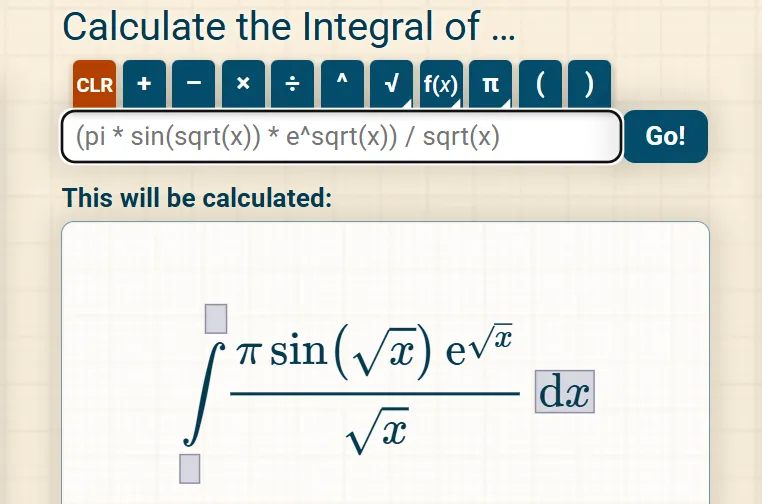What Is Integral Calculator?
An integral calculator is a powerful mathematical tool that computes definite and indefinite integrals of functions. Whether you're a student learning calculus, a professional mathematician, or someone who needs to solve complex mathematical problems, this calculator provides accurate integration results with step-by-step solutions.
Our integral calculator supports a wide range of mathematical functions including polynomials, trigonometric functions, exponential functions, logarithmic functions, and many other complex expressions. It helps you find areas under curves, volumes of revolution, and antiderivatives of functions.
Integration Formulas and Methods
The integral calculator uses various mathematical techniques and formulas to solve integration problems. These methods are fundamental to calculus and are used by mathematicians and scientists worldwide.
Basic Integration Rules
∫ xⁿ dx = xⁿ⁺¹/(n+1) + C (n ≠ -1)
Power rule for integration
∫ eˣ dx = eˣ + C
Integration of exponential function
∫ 1/x dx = ln|x| + C
Integration of reciprocal function
Trigonometric Integration
∫ sin(x) dx = -cos(x) + C
Integration of sine function
∫ cos(x) dx = sin(x) + C
Integration of cosine function
∫ sec²(x) dx = tan(x) + C
Integration of secant squared
Integration Techniques
∫ u dv = uv - ∫ v du
Integration by parts formula
∫ f(g(x))g'(x) dx = ∫ f(u) du
Substitution method (u-substitution)
∫ f(x) dx = F(b) - F(a)
Definite integral evaluation
Types of Integrals
📊 Definite Integrals
Definite integrals calculate the exact area under a curve between two specific points. They provide numerical results and are essential for applications in physics, engineering, and economics.
∫ₐᵇ f(x) dx = F(b) - F(a)
🔢 Indefinite Integrals
Indefinite integrals find the antiderivative of a function, including the constant of integration. They represent families of functions and are fundamental to calculus.
∫ f(x) dx = F(x) + C
🔄 Multiple Integrals
Multiple integrals extend integration to functions of several variables. Double and triple integrals are used for calculating areas, volumes, and other higher-dimensional quantities.
∬ f(x,y) dx dy
⚡ Improper Integrals
Improper integrals handle functions with infinite limits or discontinuities. They are essential for analyzing functions that don't behave well at certain points.
∫₀^∞ f(x) dx
Why Use Our Integral Calculator?
- Accurate Calculations: Uses advanced mathematical algorithms for precise integration results
- Step-by-Step Solutions: Provides detailed explanations of the integration process
- Multiple Methods: Supports various integration techniques including substitution and parts
- Complex Functions: Handles polynomials, trigonometric, exponential, and logarithmic functions
- Graphical Representation: Visualizes functions and their integrals for better understanding
- Educational Tool: Perfect for students learning calculus and integration concepts
- Mobile Friendly: Works perfectly on all devices - access your integral calculator anywhere
- Completely Free: No registration, no download, no hidden charges
Integral Calculator Examples
Example 1: Basic Polynomial Integration
Function:
f(x) = 3x² + 2x + 1
Solution:
∫(3x² + 2x + 1) dx = x³ + x² + x + C
Example 2: Trigonometric Integration
Function:
f(x) = sin(x) + cos(x)
Solution:
∫(sin(x) + cos(x)) dx = -cos(x) + sin(x) + C
Example 3: Definite Integral
Function:
f(x) = x² from 0 to 2
Solution:
∫₀² x² dx = [x³/3]₀² = 8/3 - 0 = 8/3
Applications of Integration
Mathematics & Science
- Area Calculation: Finding areas under curves and between functions
- Volume Computation: Calculating volumes of revolution and 3D shapes
- Physics Applications: Work, energy, and motion calculations
- Probability Theory: Computing probability distributions and expectations
Engineering & Technology
- Signal Processing: Analyzing and processing electrical signals
- Control Systems: Designing and analyzing feedback systems
- Fluid Dynamics: Modeling fluid flow and pressure distributions
- Structural Analysis: Computing stresses and deformations in materials
Frequently Asked Questions
What is the difference between definite and indefinite integrals?
A definite integral calculates the exact area under a curve between two specific points and gives a numerical result. An indefinite integral finds the antiderivative of a function and includes a constant of integration, representing a family of functions.
How does the integral calculator handle complex functions?
The integral calculator uses various integration techniques including substitution, integration by parts, partial fractions, and trigonometric identities to handle complex functions. It can process polynomials, trigonometric, exponential, and logarithmic functions.
Can I use the calculator for multiple integrals?
Yes, the integral calculator supports multiple integrals including double and triple integrals. This is useful for calculating areas, volumes, and other higher-dimensional quantities in multivariable calculus.
Does the calculator show the integration steps?
Yes, the integral calculator provides detailed step-by-step solutions, making it an excellent educational tool. It shows the integration process, including any substitutions or techniques used to solve the problem.
Is this integral calculator suitable for students?
Absolutely! The integral calculator is designed to be educational and user-friendly. It's perfect for students learning calculus, providing both answers and explanations to help understand the integration process.
